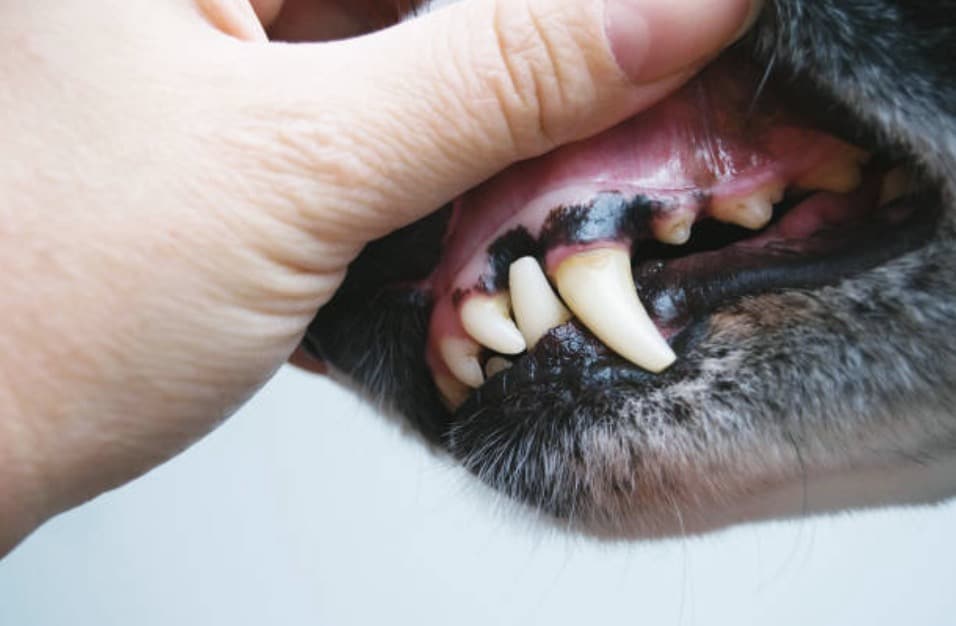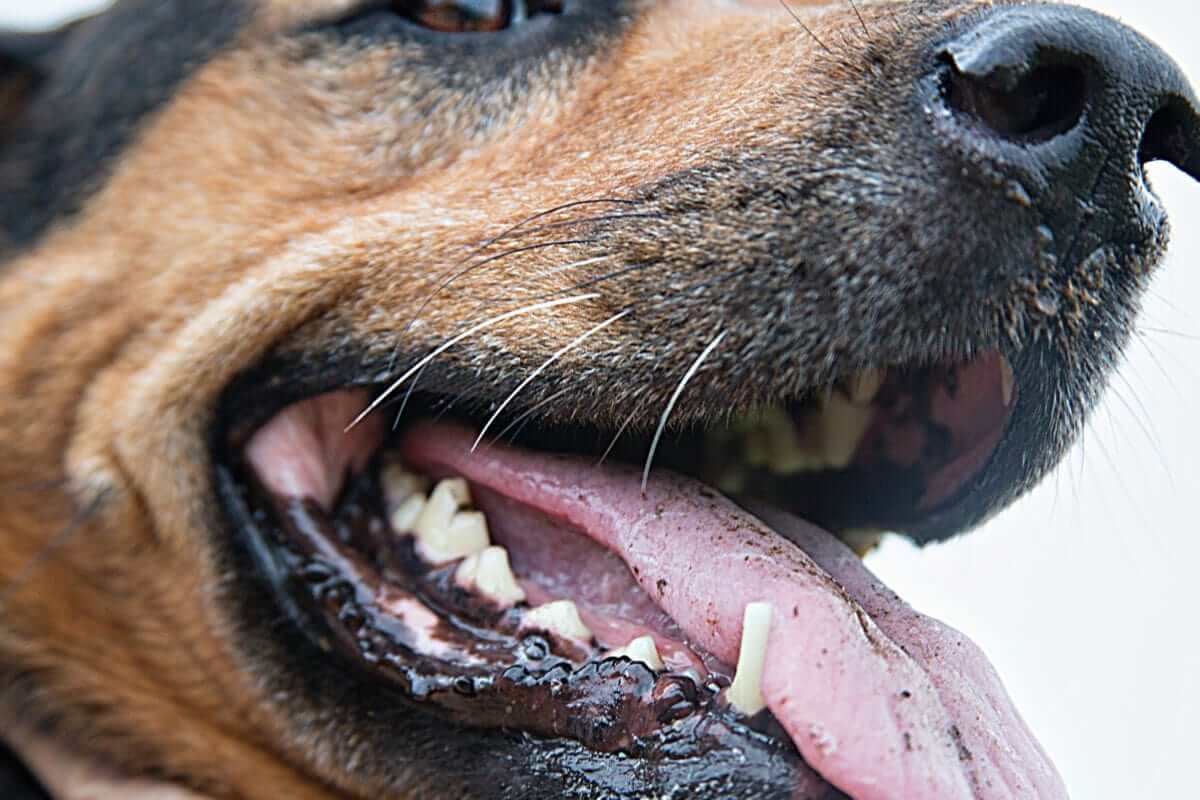Pale mucous membranes in dogs
Learning to "read" your dog's mucous membranes may seem like a far-fetched exercise, but it is an excellent way to monitor your pet's health.
This exercise, which is particularly easy to perform, tells us a lot about the state of the tissues at a local level, as well as the state of the dog's body at a systemic level. In some cases, the color of your dog's mucous membranes can even help you detect a veterinary emergency early on, thus improving the animal's prognosis considerably!
How to "read" the color of the dog's mucous membranes?
This term refers to the visual analysis of the appearance of the dog's mucous membranes in order to detect a local or systemic abnormality. There are two very practical places to examine the appearance of a dog's mucous membranes: the inner side of the lower eyelid and the gums (or mouth in general).
The examination of the gums is often preferred, because the observable surface is larger and abnormalities are therefore easier to detect. The "reading" of the mucosal color does not stop at a simple visual examination: it is also useful to press a finger on an area of the mucosa to appreciate its CRT.
The CRT (Capillary Filling Time) is the time between the moment you remove your finger from the pressed area, which then shows a white mark due to the pressure, and the moment when the mucosa returns to its original color.
Reading the color of the mucous membranes of your dog: what is the use?
The mucous membranes, unlike the dermis (skin), are highly vascularized areas, which makes it easier to observe certain blood elements. It is therefore possible to detect an oxygen deficiency, anemia, liver problems or local inflammation by examining the color of your dog's gums or eyelids.
In some cases (blue or black gums), it is an absolute veterinary emergency: knowing how to detect this type of anomaly early on can save your pet. The CRT allows you to assess your dog's blood pressure and hydration level, as well as to detect an abnormality in the blood circulation.
First of all, it is important to know that a dog's normal mucous membranes are bright pink in color, possibly with black, gray or brown spots. If these spots do not evolve and do not appear suddenly, it is probably because they are completely natural and do not indicate any abnormality.
The mucous membranes of a healthy dog should be smooth, shiny, soft to the touch and moist, without being sticky or slimy. Finally, some dogs have naturally blue gums (Chow-Chow and Shar-Pei) because of a particular pigmentation of genetic order.

My dog's mucous membranes are pink, with black spots
This is the normal color of the mucous membranes of a healthy dog, the black, gray or brown spots being due to a natural pigmentation of the tissues. The gums, tongue and inner lids of the animal should all be a relatively uniform pink color, with or without pigment spots.
The pink color of the dog's mucous membranes may vary slightly from one individual to another, depending on his age, health condition or diet. The important thing is that this color does not vary if the animal is healthy: it is the changes in appearance that should alert you.
My dog's mucous membranes are yellow, beige or orange
Yellow, beige or orange mucous membranes appear when there is an excessive concentration of bile acids in the blood, which is a sign of liver dysfunction. The yellowing of the tissues affects the whole skin of the animal, but is much easier to observe on its mucous membranes.
The gums, the tongue and the inner side of the eyelids of the animal are concerned, but also the sclera of its eye (white of the eye). Jaundice can occur as a result of gallstones, tumors, pancreatitis, hereditary pyruvate kinase deficiency or the presence of internal parasites in the dog's blood.
My dog's mucous membranes are pale or white
Pale pink or white mucous membranes indicate anemia, which is an abnormal decrease in the hemoglobin level in the blood due to a decrease in the number of red blood cells. In addition to causing unusual paleness of the mucous membranes, anemia also causes exacerbated fatigue, intolerance to exercise, increased heart rate (tachycardia) and various other non-specific symptoms.
Like jaundice, anemia usually occurs in the setting of pathology or injury and remains a symptom, not a disease in itself. A study of 1064 anemic dogs found the following causes, from the most common to the least common: tumors (22%), inflammatory diseases (22%), parasites (16%), trauma (8%), infectious diseases (7%) and organ failure (7%).
Endocrine diseases, bleeding surgeries, immune diseases, reproductive disorders and degenerative conditions account for less than 3%. Poisoning accounts for only 1% of cases, but it should be noted that anemia is one of the symptoms of rodenticide poisoning (rat poison) and other anticoagulant substances.
Finally, it is important to know that relatively common pathologies such as renal dysplasia, renal failure and stomach dilatation-torsion can also lead to a paleness of the mucous membrane.
My dog's mucous membranes are bluish or purplish
Dark mucous membranes, with a bluish or purplish color, indicate cyanosis, i.e. a decrease in oxygen in the blood.
The causes can be cardiac or respiratory, especially in cases of heart failure, asphyxia or stroke. Cyanosis is a true veterinary emergency, and the dog's chances of survival are highly dependent on prompt veterinary attention.

My dog's mucous membranes are bright red
Bright red gums are often a symptom of local inflammation, such as gingivitis or periodontal disease. In the case of a red eyelid or eye, it could be conjunctivitis or some other eye irritation or infection.
Often, there are associated symptoms that can help you identify a local infection: swelling, cloudy or colored tears in the case of red eye, and tartar or bleeding in the case of gum inflammation. Finally, red mucous membranes can also indicate hyperthermia in the dog, which can be caused by an environment that is too hot (heat stroke) or by an immune response to a disease (fever).
FAQ
Why is it important to know how to read the color of your dog's mucous membranes?
Reading the color of your dog's mucous membranes is essential to detect diseases, sometimes serious, whose symptoms include an alteration of their appearance. The easiest mucous membranes to observe are those of the dog's mouth (gums, lips and tongue) and of the eye (inner side of the lower eyelid).
What is the normal color of a dog's mucous membranes?
A healthy dog's mucous membranes are pink, smooth, soft and moist, with occasional black, brown or gray patches that should not change.
Why is my dog's mucous membrane pale or white?
Mucous membranes that are too light indicate anemia, which is a decrease in the hemoglobin level in the animal's blood that can indicate a number of diseases or injuries (tumors, hemorrhages, bone marrow damage, etc.).
Why are my dog's mucous membranes yellow or orange?
Jaundice characterizes a dysfunction of the liver causing an overdose of bile acid in the animal's blood.
Why are my dog's mucous membranes blue, purple or black?
This is a sign of cyanosis, i.e. a lack of oxygen in the dog's blood caused by a cardiac or respiratory disorder. This is a veterinary emergency and the prognosis of the animal is often vital.
Why are my dog's mucous membranes bright red?
Mucous membranes can become bright red in case of local inflammation (gingivitis, conjunctivitis, etc.) or hyperthermia.
To conclude
Learning to read the colors of your dog's mucous membranes can be very instructive, and can even allow you to save your pet's life, especially in case of cyanosis.
Don't forget that your pet doesn't have the opportunity to talk to you about his little problems, which could be a sign of more serious problems.
Regularly examining your dog's gums is an excellent way to keep an eye on the state of his teeth, but also on his overall health.


